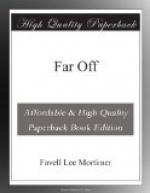VILLAGES.—Calcutta is built on a large plain called Bengal. Dotted about this plain are many villages. At a distance they look prettier than English villages, for they are overshadowed with thick trees; but they are wretched places to live in. The huts are scarcely big enough to hold human creatures, nor strong enough to bear the pelting of the storm. When you enter them you will find neither floor nor window, and very little furniture; neither chair, nor table, nor bed—nothing but a large earthen bottle for fetching water, a smaller one for drinking, a basket for clothes, a few earthen pans, a few brass plates, and a mat.
A Hindoo is counted very rich who has procured a wooden bedstead to place his mat upon, and a wooden trunk, with a lock and key, to contain his clothes; such a man is considered to have a well-furnished house.
As you pass through the villages, you may see groups of men sitting under the trees smoking their pipes, while children, without clothes, are rolling in the dust, and sporting with the kids. Prowling about the villages are hungry dogs and whining jackalls, seeking for bones and offal; but the children are too much used to these creatures to be afraid of them. Hovering in the air are crows and kites, ready to secure any morsel they can see, or even to snatch the food, if they can, out of the children’s little hands.
What a confused noise do you hear as you pass along! barking, whining, and squalling, loud laughing, and incessant chattering. It is a heathen village, and the sweet notes of praise to God are never sung there.
Yet in every village there is a little temple with an idol, and a priest to take the idol, to lay it down to sleep, and to offer it food, which he eats himself.
The poor people bring the food for the idol with flowers, and place it at the door of the temple.
APPEARANCE.—The Hindoos are pleasing in their appearance, for their features are well-formed, their teeth are white, and their eyes have a soft expression. The women take much pains to dress their long black hair, which is soft as silk: they gather it up in a knot at their heads, and crown it with flowers. They have no occasion for a needle to make their dresses, as they are all in one piece. They wind a long strip of white muslin (called a saree) round their bodies, and fold it over their heads like a veil, and then they are full dressed, except their ornaments, and with these they load themselves; glass rings of different colors on their arms, silver rings on their fingers and toes, and gold rings in their ears, and a gold ring in their nose.
The men wear a long strip of calico twisted closely round their bodies, and another thrown loosely over their shoulders; but this last they cast off when they are at work: it is their upper garment. On their heads they wear turbans, and on their feet sandals. The clothes of both men and women are generally white or pink, or white bordered with red.




